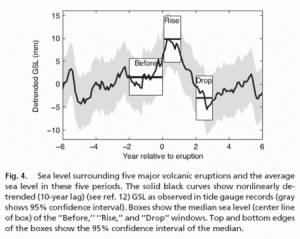We examined the impact of the 5 & 9 most major volcanic eruptions on global sea level. We construct a record of sea level and its uncertainty since 1854. From this we isolate the volcanic signature which surprisingly behaves very differently than models predict.
The mechanism that explains the result is:
- Large volcanic eruption inject aerosols into the stratosphere
- These aerosols reflect sunlight causing a global dimming, thus lowering temperatures at the earth surface.
- The cooling of the ocean ‘skin’ causes less evaporation.
Less evaporation leads to less precipitation and hence less water in terrestrial reservoirs and less river discharge.
This influences sea level in two ways:
- Lower evaporation cause an imbalance in water fluxes to/from the ocean. -Sea level rises by 9±3 mm (dependent on amount on eruption aerosol in stratosphere). After approximately one year the stratospheric aerosol has been removed and evaporation reaches normal values. However, now the river discharge is reduced due to the low precipitation in the preceding years and sea level therefore drops accordingly.
- The lower ocean temperatures lead to a densification which lowers sea level by ~7±3 mm (2-3 years after the eruption).
The water cycle disturbance causes an ‘immediate’ rise in sea level which is then followed by the drop due to ocean densification. It is the only the drop that has been modeled in the past, and no other sea level reconstruction is accurate enough to show either drop or rise in the volcanic signature.
[pdf]

